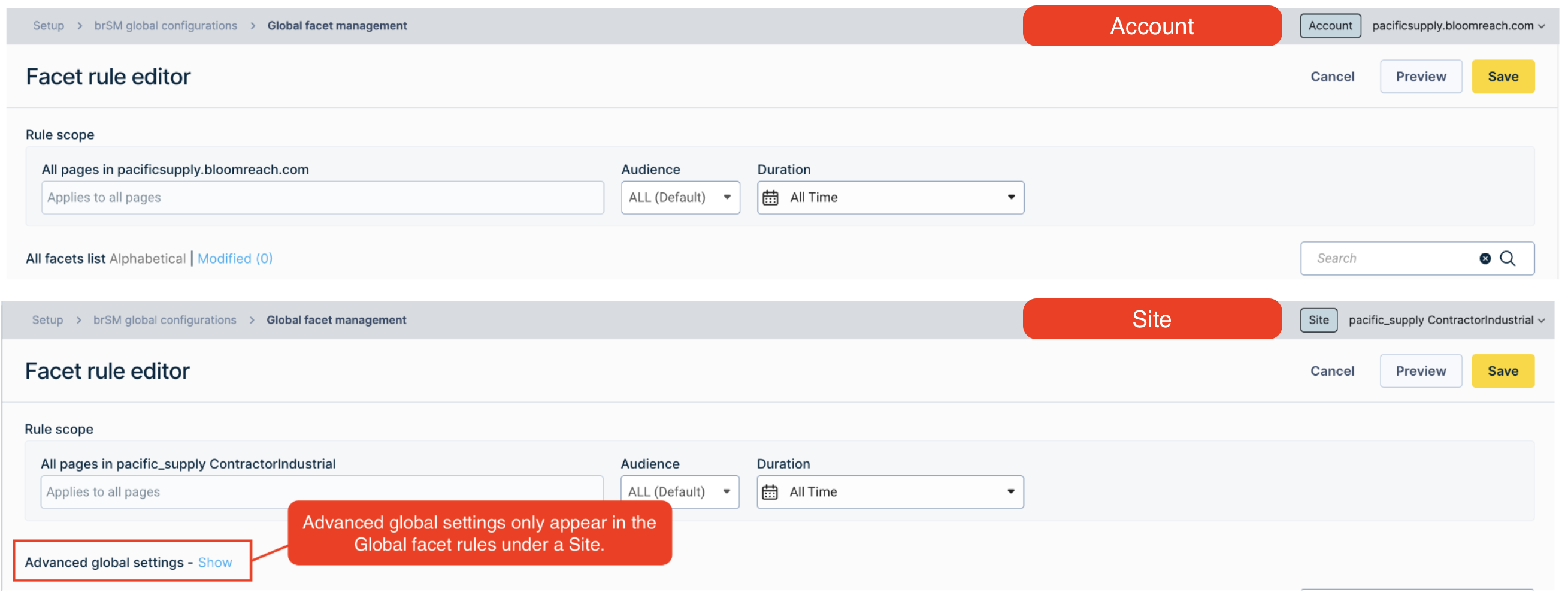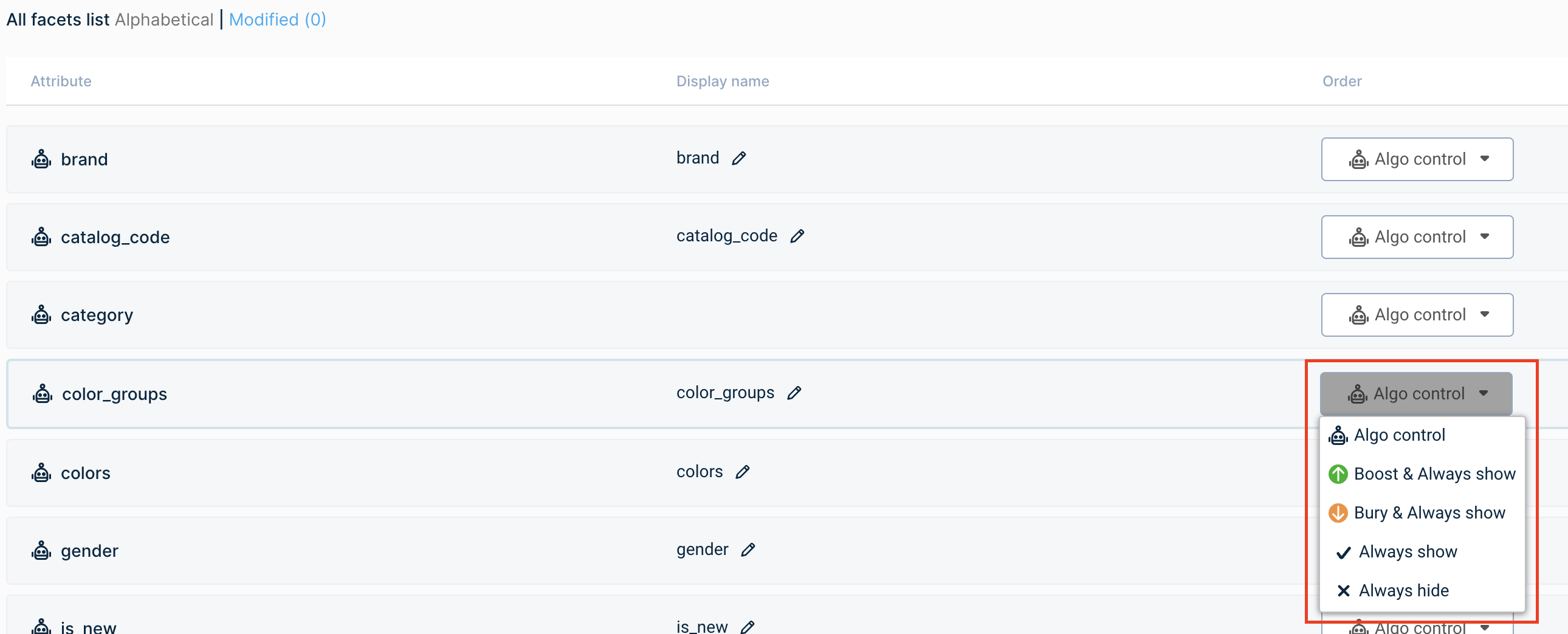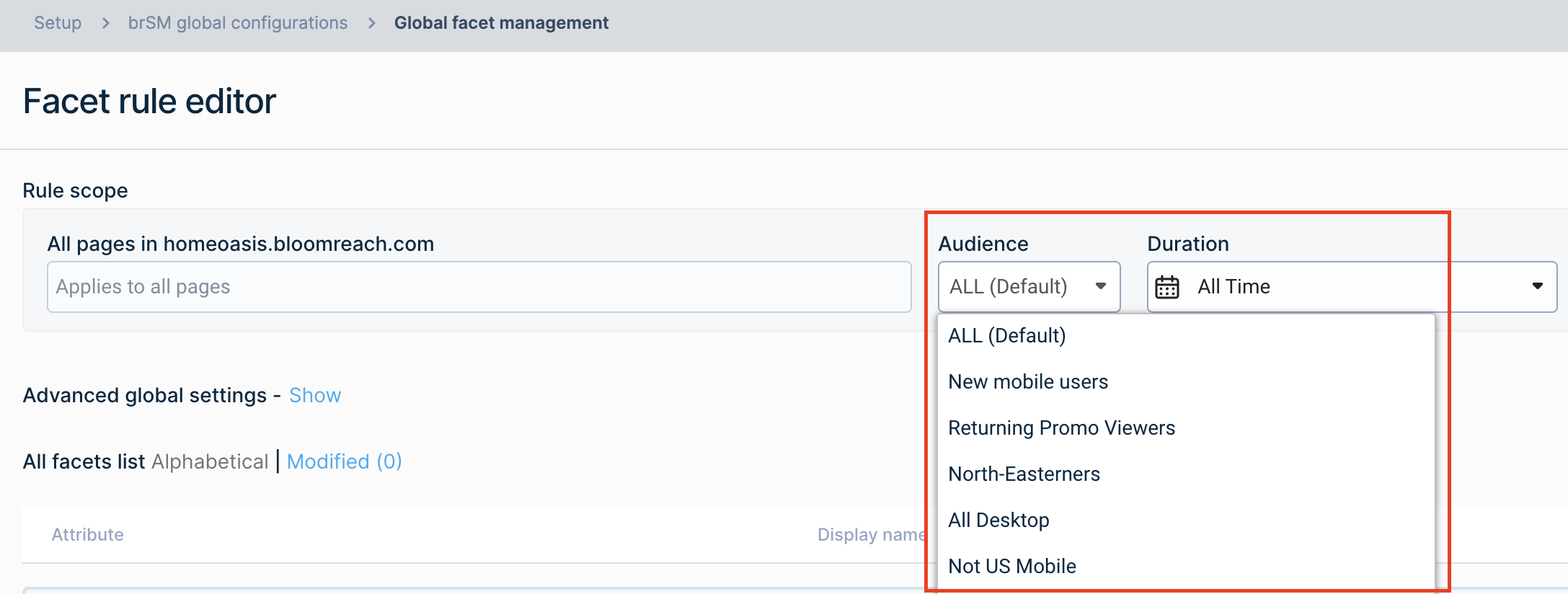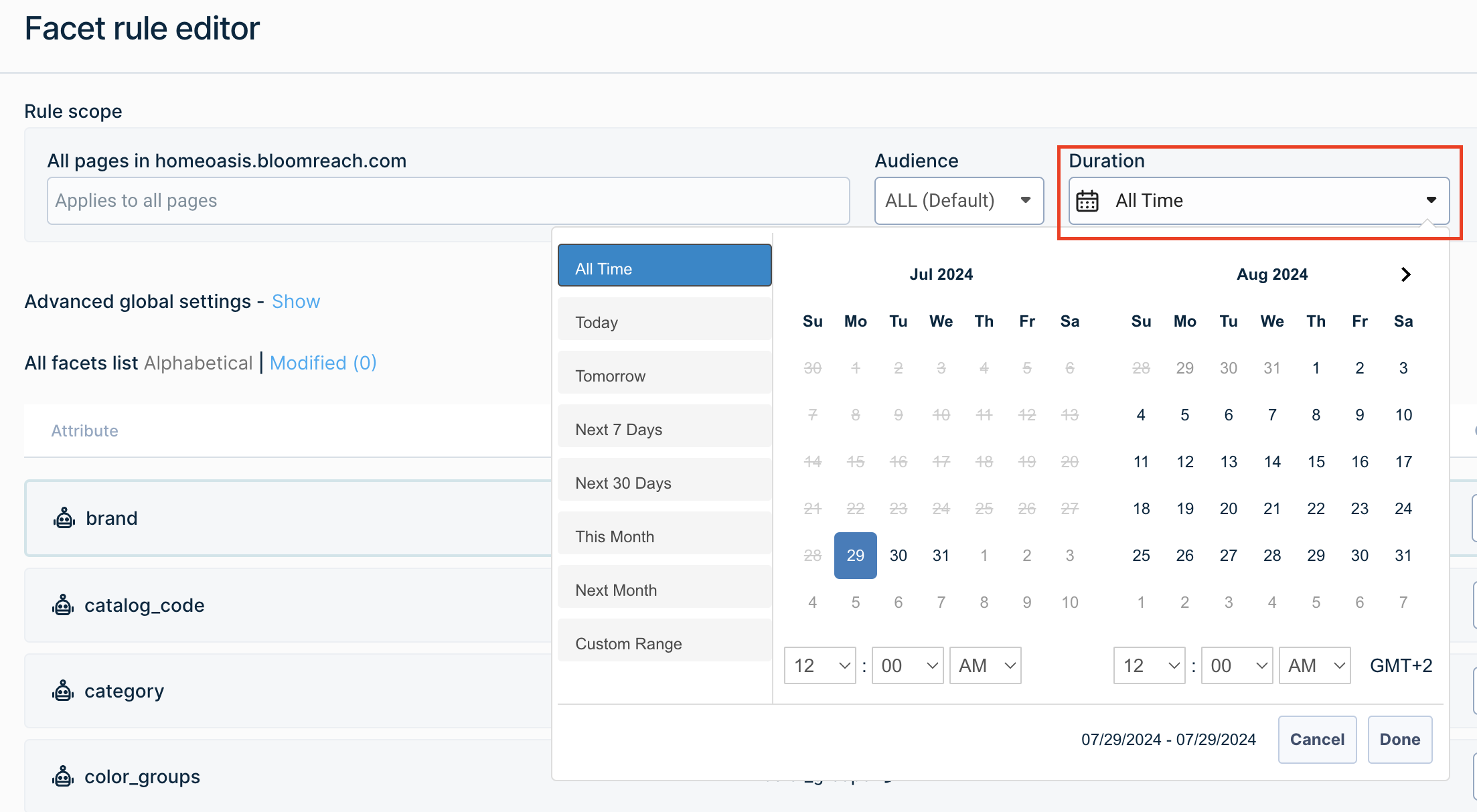Working with a global facet rule
Scenario
Laura is a digital merchandiser at Homeoasis, which is a retail site for office supplies and computer equipment. She wants to help site visitors filter search results across all pages of the site.
Additional context for Multi-site customers
If your account is set up as a multi-site account, facet operations like Facet Value Ordering and Global Facet Renaming can be done at any level, like "site global" or "account global". Please use the site selection menu at the top right corner of the navigation to select a site or account to operate at. This lets you set up unique global facet rules for different sites or accounts.
For a multi-site account, the Advanced Global Settings such as facet limits only appear in the Global facet rules under a Site. The Advanced Global Settings do not appear in the Global facet rules under an Account.
For instance, Pacific supply is a multi-site account with Maintenance Industrial as one of its sites. The Advanced Global Settings will appear in the Global facet rules of the site Maintenance Industrial and not under the Global facet rules of the account Pacific Supply. (refer to screenshot)

Create a new facet rule
Note
Click images to expand them
If the images on this page are cut off on your screen or are blurry, then you can click the images to expand them. This tip applies to any image you see in the Bloomreach help center.
Step 1. Open the facet rule editor
She starts by opening the global facet rule editor:
- Go to Merchandising > Global merchandising > Facets. The Global facets page opens.
- Click the + New rule button or click on the existing global rule denoted by * if it already exists.

Step 2. Select a page
By default, the scope of Laura's rule will apply across all pages within the Homeoasis site.

The editor displays a list of the facets available in the All Facets List.

Step 3. Choose actions
By default, the Bloomreach algorithm is currently managing all of her facets. Laura begins clicking the dropdown lists in the Order column and selecting an option.

For each facet, she chooses an order. She makes these choices:
| Facet attribute | Selected order | Result |
|---|---|---|
| category | Boost & Always Show | The category facet is always displayed for paper search term queries. Because Laura chooses to boost it, Bloomreach puts it near the start of the facets on paper search result pages. |
| brand | Algo Control | The Bloomreach algorithm manages the brand facet. |
| gender | Always Hide | The gender facet is never displayed on paper search result pages. Laura makes this choice because she determines that gender is irrelevant to paper shopping. She doesn't want it to clutter the page. |
| color_groups | Always Hide | The color_groups facet is never displayed on paper search result pages. |
| sizes | Always Show | The sizes facet is always displayed on paper search result pages, but Laura lets the Bloomreach algorithm determine where it appears. |
| colors | Bury & Always Show | The colors facet is always displayed on paper search result pages, but Laura pushes it near the end of the facets. She thinks that other facets are usually more relevant to Homeoasis's paper shoppers. |
Your facets are probably different
The facets that you see in your facet editor are probably different from Laura's facets. Facets come from product attributes, which Bloomreach pulls from your product catalog.
Maximum number of facet values
For Global Facet management, the option Max number of facet values can be used to configure the maximum number of values allowed for a facet. The default number of facet values allowed for each facet is 200. The number of values allowed can be increased to 1000.
However, if you allow more than 200 facet values for a high number of facets, or use 1000 facet values for more than one or two facets, then this could have performance implications. We do not recommend this.
The limit is allowed to 1000 for a few edge cases where you might need such a high number of values for one or two facets.
Please use this judiciously. If you have use cases where you need to set a high number of facet values for a large number of facets, then please check with us on performance issues before you proceed.

You can configure the maximum number of facet values allowed for each facet.
Guidance on Facet visibility
When configuring global facet rules, such as setting a facet to "always show," it's important to understand how facet data appears in the API response and how it renders on your website.
Expected API behavior
Let’s understand with an example: An 'offers' facet is set to “always show” across the whole website, allowing shoppers to filter by available deals.
There may be certain categories where no products are on offer currently. The ‘offers’ facet will still return in the API response with an empty array [ ]. This respects the “always show” setting, and helps you see that the facet is allowed but just has no data right now.
Bloomreach API returns all relevant facets—even those with empty values—in the API response to help you distinguish between facets that are blocked (and therefore not present at all) and facets that lack data. This transparency allows you to make an informed decision about which facets to show or hide.
Your responsibility to choose whether to display empty facets or not
The rendering of facets on your live site is your responsibility. If you don't want to display facets without values, you’ll need to add logic to hide those facets.
Step 4. Choose an audience
Laura looks at the list of audiences that she can choose for her facet rule.

By default, Laura's rule affects all site visitors. She keeps this default selection.
Targeted audiences
The Audience dropdown list is a collection of all the audiences defined in the target audience tool. An audience is a group of site visitors with a specific set of common characteristics, such as the type of device they use to browse your site. Laura's audiences are based on language. Your own selections are probably different.
Step 5. Choose a duration
Laura considers whether to set a duration for her facet rule. If she wants her changes to be temporary, then she can set a start and end date. She can select from a list of common time periods, or she can choose a custom range.

Laura doesn't want to put a time constraint on her facet rule, so she decides to keep the default duration, which is All Time.
Local timezone
Durations are set in your local timezone. If you set a rule to start at 1:30am in Los Angeles, then the rule goes into effect at 9:30am in London.
Step 6. Review actions
Laura decides to manually control the way Bloomreach handles almost every facet displayed on all pages on her site. She leaves only the brand facet in its default state.
Tip
If you're working through this scenario on your own, you might prefer to be more conservative than Laura and choose just one or two facets to change. Any facet that you don't change continues to be managed by the Bloomreach algorithm.

Before saving the rule, Laura clicks the Preview button to see how search result pages for paper look with her new facet rule.

She scrolls down to see all the facets on the left of her preview. She's happy with her facets and closes the preview.
Step 7. Save the rule
Laura clicks the Save button. The facet editor saves her new rule and returns her to the Global facets page of the Bloomreach Dashboard. Because of her default decision for the duration of the rule, it's automatically enabled for her.
However, she changes her mind and decides to disable the rule. She toggles the ON/OFF toggle in the Enable column, setting it to OFF and disabling the rule. She can return later to enable it. Or she can click the rule's name in the Identifier column to open it in the facet editor and make some changes.
And now she's done!
Updated 7 months ago
